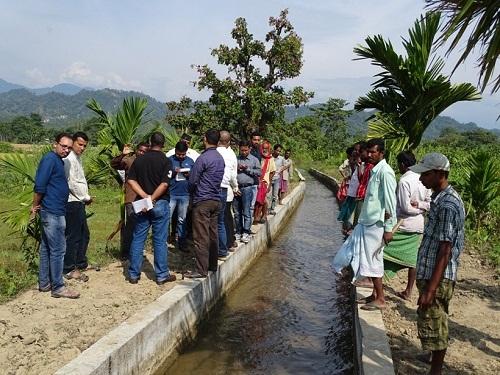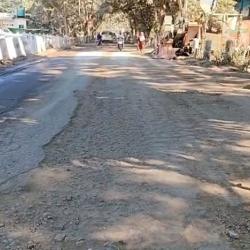Villagers in remote north-east India have revived irrigation systems to overcome water shortages and boost agriculture in a region suffering from insurgent violence and government neglect The districts of Baksa, Chirang and Udalguri of Assam on the India- Bhutan border were once lush green. However, rapid urbanisation and deforestation has turned these areas into arid zones. The once perennial sources of water are now almost dry in winter. Deforestation and climate change has made water scarce and pushed local communities towards hunger and poverty. India and Bhutan share a number of transboundary rivers. While the Indian side of the border comprises mostly of dry plains, the hills on the Bhutan side are covered with lush forests. Rivers and rivulets flow into India’s north-eastern state of Assam. Most of these water bodies originate in Bhutan and ultimately merge with the tributaries of the Brahmaputra River. These networks of water channels are the only source of water for irrigation, drinking and fishing for the local community. But during winter the channels now run dry.
Tree felling by timber traders and clearance of forest lands for development projects (such as widening roads) has led to massive deforestation and the siltation of river beds, worsening the situation. Climate change also plays a role. The number of rainy days has decreased and rain now falls heavily for a few hours, leading to sudden floods. Fluctuations of river flow have become more intense over the past 10-15 years, locals say.
Vast areas of the region now face an acute water crisis during the dry season. Without irrigation, most farmers are unable to cultivate their land. Women have to go long distances to fetch water for household chores. Further, without any mechanism to channel river water flowing from Bhutan during the rainy season, earthen canals and wooden embankments fail to withstand the pressure of the river water.
After struggling with water scarcity for almost two decades, local communities in the Nagrijuli area. located in the foothills of Bhutan, have revived the traditional canal system – locally called Dong.
Local NGO Gramya Vikash Mancha (GVM) devised a simple, cheap yet effective method of irrigation with the help of the community and the revival of the Dong is all set to change the very face of Nagrijuli Development Block. The novel intervention not only aims to boost the economic output of the village but also to check the exodus of young people leaving the village every year in search of jobs.
“Though the rivers become full of water flow in summer it becomes lean suddenly during summer or rainy days and the farmers can’t get water for irrigation. There were no canal to carry this water flow to the paddy field’ Nayan Jyoti Bhuyan, the Vice President of GVM says.
The government has not set up an irrigation system in these areas and it would be a herculean task to tap groundwater due to the rock bed beneath the ground. This paddy season the villagers revived the Dong by taking water from rivers in neighbouring Bhutan to irrigate their paddy fields, said GVM president Prithi Bhusan Deka. The NGO and the villagers constructed a 12-kilometre concrete canal along with a number of sub canals to channel the water flow of the Oranga river to irrigate 10,000 acres of cultivated land, mostly rice paddy.
The gurgling water has brought cheer to farmers who are now gathering a bumper harvest. Villagers want the government replicate the method throughout the entire Nagrijuli area. Villagers who have already had good harvest are now preparing for winter (Rabi crop) cultivation. Dharma Das, from Guabari village, said that after 20 years they had got a good harvest and he hoped good times will prevail as the irrigation system has helped with the use of modern technology like construction of sluice gates and concrete canals.
Villagers have harvested substantial amount of rice this winter using the canals to bring water to their paddy fields. On average, farmers have harvested on average 680 kilogrammes of rice per bigha (about 3 acres) of land, compared to about 280 kilogrammes rice produced without the canal water supply.
Daranga River with a lean water flow from Bhutan Hills GVM aims to improve the quality of life of at least 60,000 families in Baksa, Nalbari and Kamrup districts of Assam within the next three years.
In the past, the earthen canals needed regular repairing by the community members, particularly whenever there was heavy water flow. Using concrete has solved this problem. “The construction of sluice gates has made it easier for us to store water for days and then use it,” Das added.
There are about hundred small tea growers and around 500 hectares of land under tea cultivation in the Assam- Bhutan border area. There is greater potential for tea cultivation in the area, provided irrigation facilities are improved, Das says.
The area lacks basic facilities such as schools, hospitals, electricity, roads or livelihood opportunities, as a result of which a large number of youths from the area have migrated to other places in search of employment.
Government officers and workers do not implement development schemes in remote villages, using the insurgency as an excuse.The Bhutan-Assam border region has suffered violent insurgency over the past two decades.
When the government launches military operations, insurgents are forced to take refuge in the forests of Bhutan. In 2003 Bhutan launched a counter-insurgency operation against insurgent groups including the United Liberation Front of Assam (ULFA) and drove them out of Bhutan. Another group, the National Democratic Front of Bodoland, is still operating in the region, though some members are involved in peace dialogues. The insurgent groups are demanding autonomy and greater political rights from central and state governments.
Villagers say if the government wants to prevent young people from joining insurgency groups then they should implement development schemes.
- 19042 reads








Add new comment